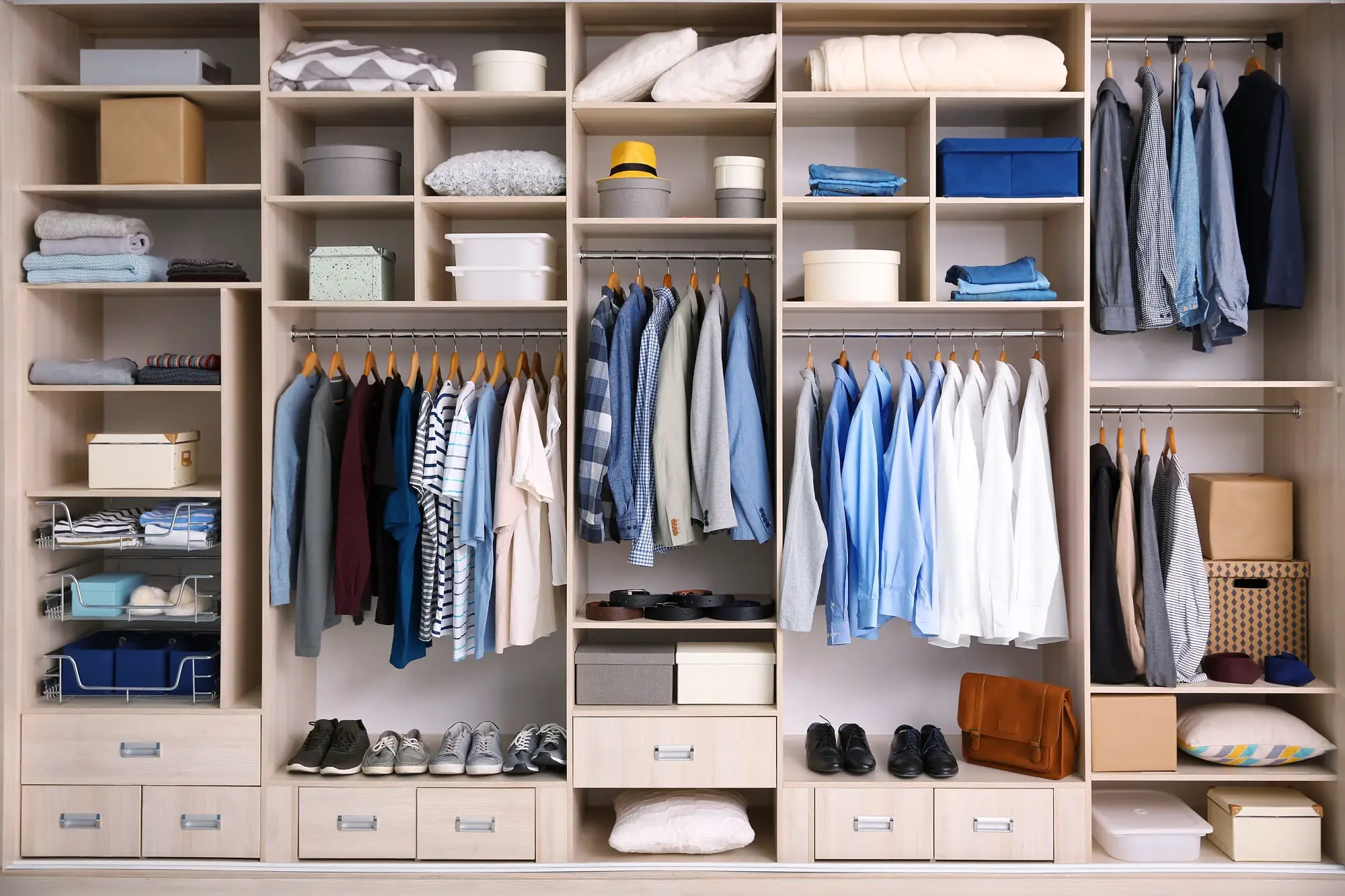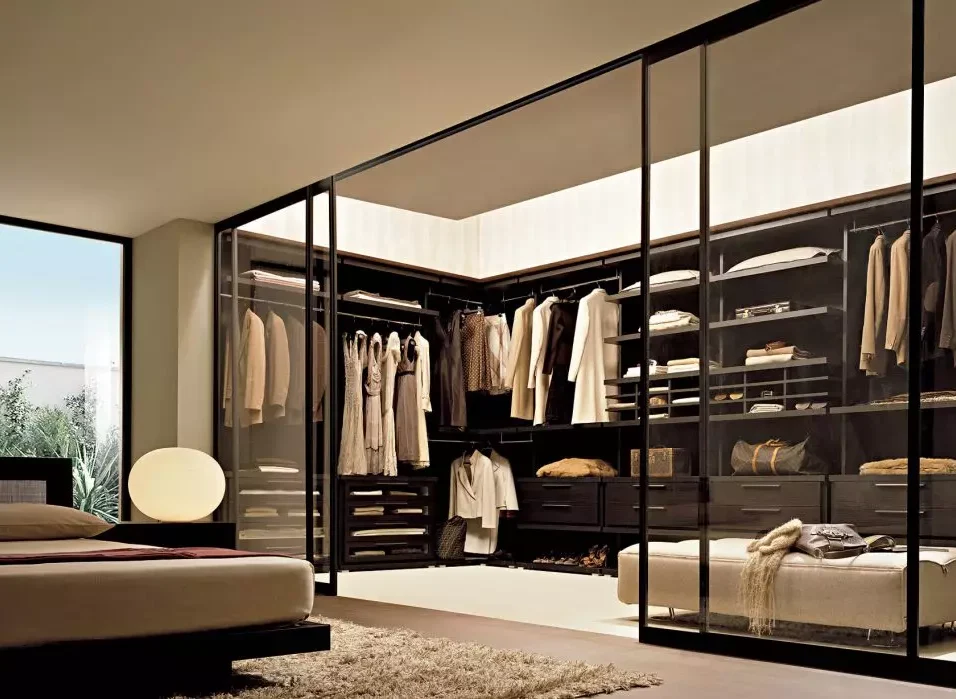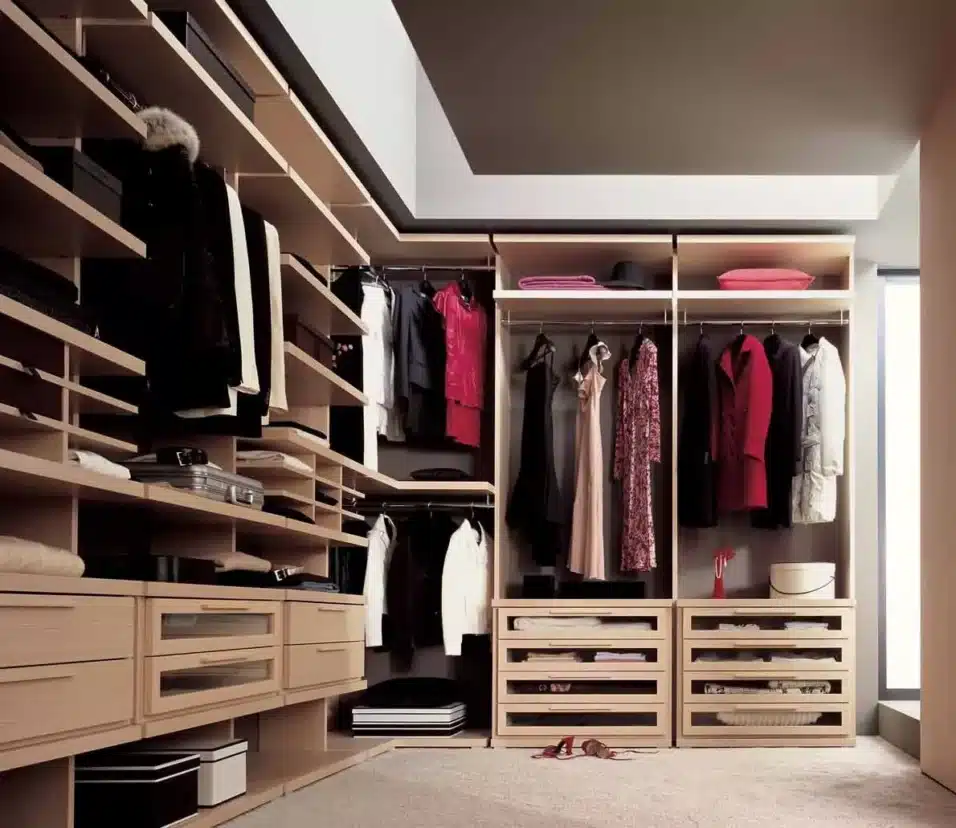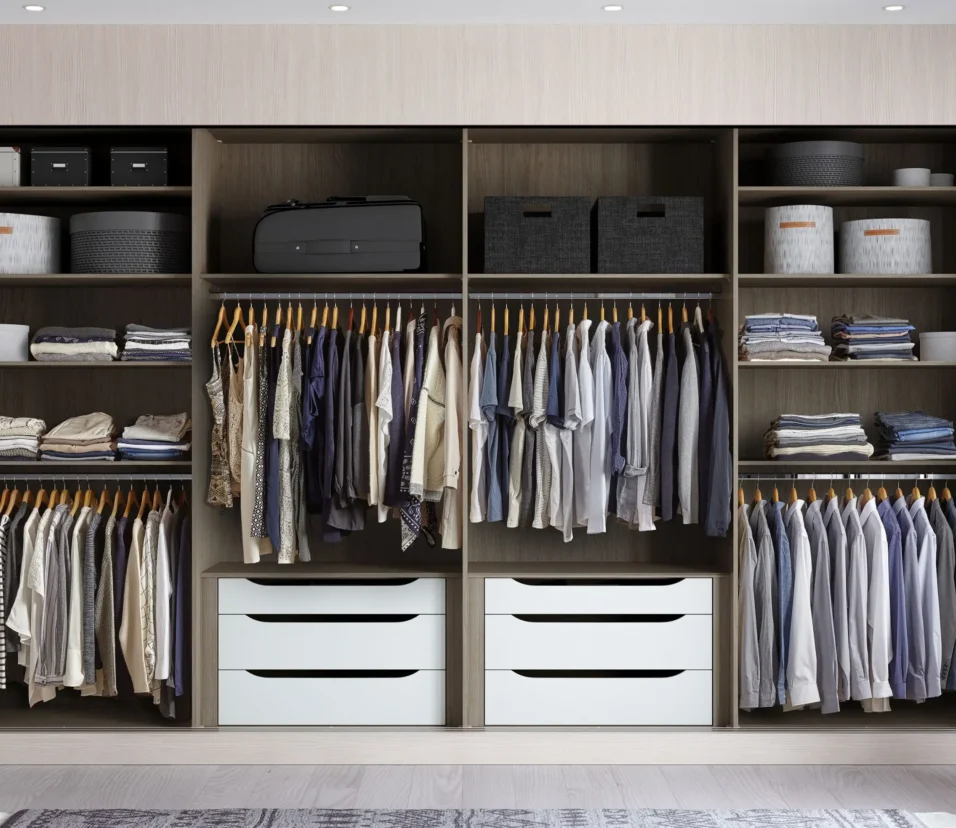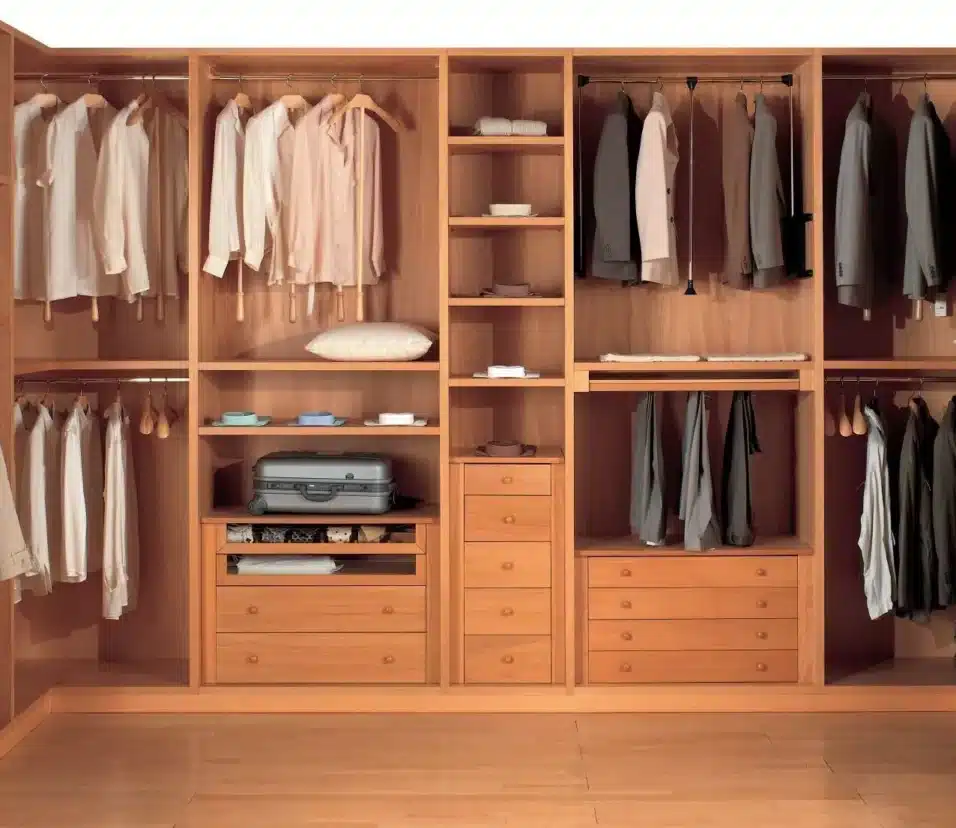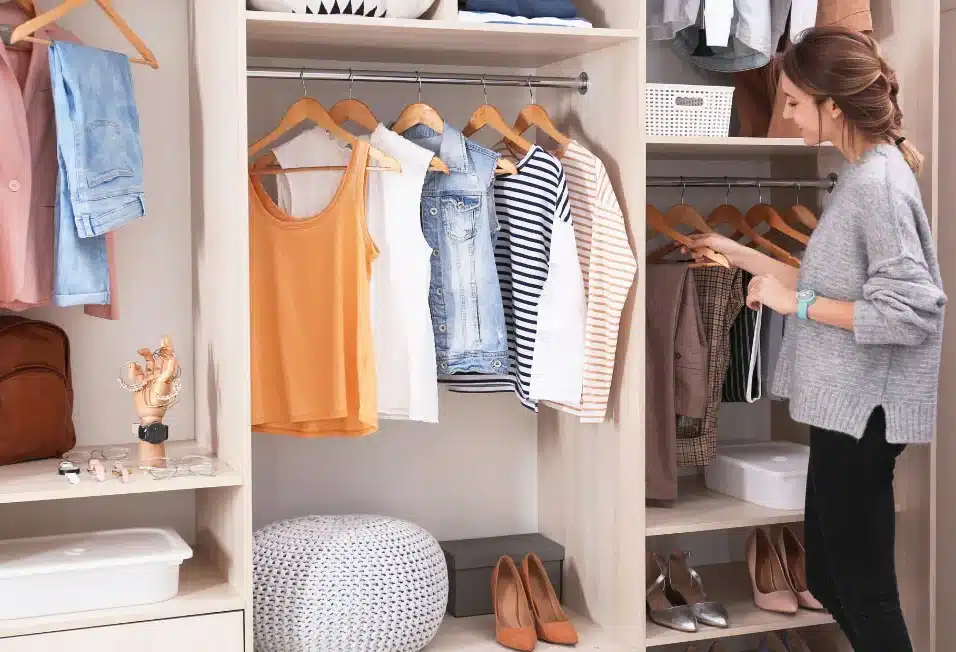How To Redo Wardrobe
Introduction
How To Redo Wardrobe: where the art of revitalizing your personal style meets the thrill of curating a closet that resonates with your essence. In a world where self-expression is paramount, your wardrobe becomes a canvas upon which you paint your evolving identity.
Life is a series of chapters, and each chapter is accompanied by a distinct version of you. Whether you’re transitioning into a new phase, seeking to infuse fresh energy into your daily attire, or simply embracing change, this guide is your steadfast companion on the journey to rediscover and redefine your style.
“How To Redo Wardrobe” is more than just fashion advice – it’s a roadmap to cultivating a wardrobe that encapsulates your authentic self. From assessing your current collection to embracing sustainable fashion choices, we will navigate the multifaceted process of curating a professional wardrobe that reflects your personality and aspirations.
In a world where trends fade and individuality shines, this guide empowers you to break free from the mold and craft a closet that celebrates your uniqueness. Get ready to embrace the joy of experimentation, the thrill of discovery, and the confidence that comes from expressing who you are through your clothing. Whether you’re a fashion enthusiast or a novice, “How To Redo Wardrobe” is here to inspire, guide, and uplift. Your wardrobe transformation starts now, as you embark on a journey of style evolution and self-discovery, one well-curated piece at a time.
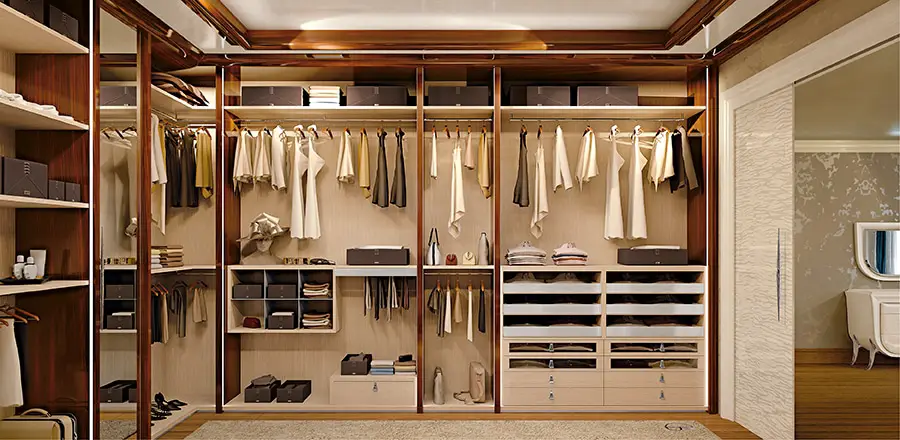
How do I update my existing wardrobe?
Top Tips To Update Your Wardrobe Without Spending Much Money
- Identify Which Fashion Items You Need.
- Join a Clothes Swap.
- Use Discount Coupons to Pick Up Some Bargains.
- Sell Unwanted Clothes.
- Turn Old Items into New Ones.
- Pay Attention to Styling.
- Go Minimal with a Capsule Wardrobe.
Updating your existing wardrobe is a fantastic way to breathe new life into your style without starting from scratch. Here’s how you can update your wardrobe:
Assess Your Wardrobe:
Begin by going through your current clothing collection. Identify items you love, those you rarely wear, and pieces that need replacing.
Define Your Style:
Consider the direction you want your style to take. Look for inspiration online, in magazines, and on social media to refine your vision.
Identify Gaps:
Note any gaps in your wardrobe – pieces that would complement what you already own. These gaps will guide your shopping.
Mix and Match:
Experiment with pairing items in new ways to create fresh outfits. Mix colors, patterns, and textures for an updated look.
Accessories Overhaul:
Accessories can transform an outfit. Invest in statement jewelry, belts, scarves, and bags to add flair to your ensembles.
Incorporate Trends Sparingly:
Choose a few current trends that resonate with your style and incorporate them thoughtfully into your existing wardrobe.
Focus on Quality:
Invest in key pieces that are versatile and well-made. Quality items will elevate your entire wardrobe.
Repurpose and Restyle:
Look at your existing pieces with a fresh eye. Can a dress be worn as a tunic? Can a shirt be knotted at the waist? Get creative with restyling.
Tailoring and Alterations:
Consider getting pieces tailored for a better fit. Well-fitting clothing instantly looks more polished.
Neutral Staples:
Invest in neutral-colored staples like blazers, pants, and skirts. These pieces can anchor various outfits.
Statement Pieces:
Acquire a few statement items like bold prints or unique accessories that can instantly update your look.
Donate and Declutter:
Let go of items you no longer wear. Donate or sell them to make space for new additions.
Mix High and Low:
Mix high-end pieces with more affordable finds for a balanced and interesting look.
Layering and Textures:
Experiment with layering and combining different textures to add depth and interest to your outfits.
Personalize:
Customize your pieces by adding patches, embroidery, or other embellishments to give them a unique touch.
Try New Colors:
Experiment with colors you haven’t worn much before. Adding a new color to your wardrobe can revitalize your style.
Stay Organized:
Keep your closet organized so you can easily see and access your updated pieces. So step into the world with renewed flair, inspired by the freedom to express yourself through your revamped wardrobe. Whether wardrobes should be the same color as walls depends on your personal preferences, design goals, and the overall aesthetic you’re trying to achieve in your space. There’s no hard and fast rule, and both matching and contrasting color schemes can work well.
Updating your existing wardrobe allows you to build upon what you already have, making your style more current and reflective of your evolving tastes. Be open to experimentation, and have fun rediscovering your clothing collection in a whole new light.
How do I redo my wardrobe on a budget?
7 budget-friendly ways to update a wardrobe
- Investigate your closet (and others’) Take stock of what’s already in your closet and drawers.
- Turn pants into shorts or capris.
- Invest in basics.
- Set your budget and shopping plan.
- Shop from the back.
- Stick to a neutral color palette.
- Shop thrift sales or consignment.
Redoing your wardrobe on a budget requires careful planning, creative thinking, and strategic shopping. So step into the world with renewed flair, inspired by the freedom to express yourself through your revamped wardrobe. Here’s a step-by-step guide to help you revamp your wardrobe without overspending:
Assess Your Current Wardrobe:
Start by evaluating what you already own. Identify items you love, those that need replacing, and pieces you can repurpose or restyle.
Set a Budget:
Determine a realistic budget for your wardrobe makeover. This will help you make conscious spending decisions.
Define Your Style:
Clarify your personal style and the direction you want to take with your new wardrobe. Look for inspiration online and create a mood board to guide your choices.
Identify Key Pieces:
Make a list of essential items you need to create versatile outfits. Prioritize basics like jeans, neutral tops, and classic outerwear.
Shop Sales and Discounts:
Take advantage of sales, discounts, and clearance events. This is an excellent way to get quality items at reduced prices.
Secondhand and Thrift Shopping:
Explore thrift stores, consignment shops, and online platforms for affordable finds. You can discover unique pieces without breaking the bank.
Swap or Trade:
Organize clothing swaps with friends or attend local swap events. This lets you exchange items you no longer need for ones that align with your new style.
Repurpose and Restyle:
Get creative with repurposing and restyling your existing items. Mix and match pieces in new ways to create fresh outfits.
DIY and Customization:
Update your clothing with DIY projects like distressing jeans, adding patches, or altering hemlines for a personalized touch.
Focus on Versatility:
Choose items that can be mixed and matched to create various outfits. Versatile pieces offer more styling options.
Accessories:
Accessories can transform your look. Invest in statement jewelry, scarves, belts, and bags to enhance your outfits.
Prioritize Quality:
Invest in well-made basics that will last longer. Quality items may cost more upfront but offer better value over time.
Stay Organized:
Keep track of your purchases and stay organized to avoid overspending or buying duplicates.
Avoid Impulse Buys:
Stick to your budget and shopping list. Avoid impulse purchases that might not fit your overall style plan.
Sell or Donate Unwanted Items:
Sell clothing you no longer wear online or donate to make room for new additions.
Build Gradually:
Remember that redoing your wardrobe doesn’t need to happen all at once. Gradually acquire pieces as your budget allows.
Can I repaint my wardrobe?
If you’re tired of looking at an outdated wardrobe that no longer matches your bedroom style, it’s time for a change! Fortunately, a new coat of paint can dramatically change the look of the piece. If you’ve painted wood before, you’re probably familiar with sanding and priming the surface.
Yes, you can repaint your wardrobe to give it a fresh and updated look. Repainting your wardrobe is a creative and cost-effective way to transform its appearance without the need for a complete replacement. Here’s how you can go about repainting your wardrobe:
Preparation:
Remove all the items from the wardrobe and clean the surfaces thoroughly. Sand the surfaces lightly to create a smooth base for the new paint to adhere to.
Choose the Right Paint:
Select a paint that is suitable for the material of your wardrobe. For wooden wardrobes, you can use latex or oil-based paints. Make sure to choose a paint finish (matte, satin, gloss) that suits your desired look. So step into the world with renewed flair, inspired by the freedom to express yourself through your revamped wardrobe.
Gather Supplies:
You’ll need paint, paintbrushes or rollers, painter’s tape, drop cloths or newspapers to protect the surrounding area, and a primer if necessary.
Prime (If Needed):
If your wardrobe has a dark or stained finish, it’s recommended to apply a primer before painting. Primer helps the new paint adhere better and provides a consistent base color.
Test the Color:
Before applying the new paint, test it on a small, inconspicuous area to ensure you’re happy with the color and finish.
Apply the Paint:
Start painting your wardrobe with even brush strokes or a roller. Apply multiple thin coats rather than a single thick coat to achieve a smooth finish. Allow each coat to dry completely before applying the next.
Pay Attention to Details:
Remove hardware like handles and knobs before painting, or cover them with painter’s tape. Paint around these areas carefully for a neat result.
Let it Dry:
Once you’ve finished painting, allow your wardrobe to dry completely. This may take several hours or even a day, depending on the type of paint you used.
Apply a Clear Coat (Optional):
Applying a clear protective coat, such as a polyurethane sealer, can help protect the painted surface and give it a durable finish.
Reassemble and Decorate:
Once the paint is completely dry and any protective coating is applied, reassemble the wardrobe, put back the hardware, and organize your items inside.
Repainting your wardrobe can give it a whole new lease of life and help it seamlessly fit into your updated style or decor. Just make sure to take your time, follow proper painting techniques, and choose a color that complements your overall design vision.
How much is a wardrobe makeover?
A Guide on What a Personal Stylist Does, How Much They Cost …
How much does a stylist cost? The price of personal stylists can vary depending on where you are located. There are personal stylists in the USA that charge anywhere from $75 to $250 per hour, with an average cost of around $150 per hour for an online personal stylist.
The cost of a wardrobe makeover can vary widely depending on several factors, including your location, the extent of the makeover, the quality of items you’re looking to add, and whether you’re working with existing pieces or starting from scratch. Here’s a breakdown of potential costs involved:
Clothing and Accessories:
The cost of new clothing and accessories will depend on your budget and the items you’re looking to purchase. You can find budget-friendly options at thrift stores or spend more on high-quality pieces from designer brands.
Tailoring and Alterations:
If you need to have existing pieces tailored or altered to fit perfectly, there will be additional costs for these services.
Organization and Storage Solutions:
If part of your makeover involves reorganizing your closet with new hangers, dividers, storage bins, and other organization solutions, these items will contribute to the cost.
Styling and Consultation Services:
If you decide to work with a personal stylist or fashion consultant, their fees will add to the overall cost.
Repainting or Refinishing:
If you plan to repaint or refinish your wardrobe, you’ll need to budget for paint, primer, brushes, and other supplies.
DIY vs. Professional Help:
Whether you’re doing the makeover yourself or seeking professional assistance will impact the cost. DIY projects may be more budget-friendly, while hiring experts might incur additional fees.
Frequency:
How often you redo your wardrobe can affect the overall cost. If you’re updating your wardrobe seasonally, the costs might be spread out over the year. If it’s a one-time overhaul, the cost might be higher initially.
Location:
The cost of items and services can vary based on your location and local market prices.
It’s important to establish a budget that works for you and to be mindful of your spending throughout the process. A wardrobe makeover can be tailored to fit various budgets, from small changes and thrifty updates to more extensive transformations. Planning ahead, setting priorities, and making thoughtful choices can help you achieve the desired result within your budget.
How often should I redo my wardrobe?
Whether it’s a new pair of classic jeans or shoes that are on-trend-yet-timeless, it makes sense to give yourself a small update every year. You can even swap out items that no longer work by donating or selling them.
The frequency of redoing your wardrobe can vary based on individual preferences, lifestyle, and changes in fashion trends. There’s no set rule for how often you should update your wardrobe, but here are some factors to consider when determining the right timing for you:
Seasonal Updates:
Many people choose to refresh their wardrobe with the changing seasons. This could mean updating your clothing collection four times a year – for spring, summer, fall, and winter. Seasonal updates help you adapt to changing weather and stay current with fashion trends.
Fashion Trends:
If staying on top of current fashion trends is important to you, you might opt for more frequent updates to incorporate new styles and looks.
Lifestyle Changes:
Major life changes like starting a new job, moving to a different climate, or experiencing shifts in your personal life can prompt the need for a wardrobe update.
Wear and Tear:
As clothes are worn and washed, they can show signs of wear and tear. You might need to update your wardrobe more frequently if your clothing starts to look worn or outdated.
Personal Style Evolution:
As your personal style evolves over time, you might feel the desire to update your wardrobe to reflect your changing tastes.
Budget:
Your budget can influence how often you’re able to redo your wardrobe. Assess your financial situation and allocate funds accordingly.
Quality of Clothing:
Investing in higher-quality clothing can mean you need to update your wardrobe less frequently. Quality pieces tend to last longer and withstand trends better.
Capsule Wardrobe Approach:
If you’ve adopted a capsule wardrobe strategy, you might refresh your wardrobe less often, focusing on carefully chosen, timeless pieces.
Regular Assessment:
Regularly assess your wardrobe to identify items you no longer wear or that no longer align with your style. This will help you determine when it’s time for an update.
Special Occasions:
Events like weddings, vacations, or formal gatherings might prompt a wardrobe update to ensure you have the appropriate attire.
Ultimately, the frequency of redoing your wardrobe depends on your individual needs and preferences. Listen to your intuition and pay attention to signs that it’s time for an update. Whether you choose to update your wardrobe seasonally, annually, or whenever you feel the need for change, the key is to create a collection of clothes that reflects your style, meets your needs, and makes you feel confident and comfortable.
What is a good budget for a wardrobe?
According to Dunn, you should spend 5% of your monthly income on clothing. To find the exact dollar amount you should be spending per month, multiply your take-home pay by 0.05. For example, if your monthly take-home pay is $3000, you should spend around $150 per month on clothing.
The ideal budget for a wardrobe can vary widely based on individual circumstances, preferences, and lifestyle. There’s no one-size-fits-all answer, but here are some general guidelines to consider when setting a budget for your wardrobe:
Allocate a Percentage of Income:
A common rule of thumb is to allocate around 5-10% of your monthly income for clothing and fashion-related expenses. This percentage can be adjusted based on your financial goals, priorities, and other financial responsibilities.
Prioritize Quality Over Quantity:
Instead of focusing solely on the quantity of items you can buy, prioritize investing in quality pieces that will last longer and provide better value over time.
Assess Your Needs:
Consider your lifestyle and professional requirements. Someone with a formal job might allocate more budget for work attire, while someone with a casual lifestyle might spend more on everyday clothes.
Frequency of Updates:
Determine how often you plan to update your wardrobe. If you’re looking for seasonal updates, you might need a higher budget compared to someone who updates their wardrobe less frequently.
Shop Strategically:
Take advantage of sales, discounts, and secondhand options to stretch your budget further.
Consider Different Categories:
Break down your budget into categories like clothing, shoes, accessories, and special occasions. This can help you allocate funds based on your priorities.
Set Realistic Expectations:
Be honest about what you can afford. Avoid overspending and stick to a budget that aligns with your financial situation.
Plan for Special Occasions:
Consider events or occasions that might require special attire. Allocate funds accordingly to avoid last-minute spending.
Balance Your Spending:
Aim for a balance between investment pieces and more affordable finds. This ensures your wardrobe is both versatile and stylish.
DIY and Repurposing:
If you’re on a tight budget, consider DIY projects, repurposing items, or shopping secondhand to reduce costs.
Capsule Wardrobe Approach:
If you’re interested in minimalism, a capsule wardrobe can help you focus on a smaller number of versatile pieces within a set budget.
Review and Adjust:
Regularly review your spending and adjust your budget as needed based on your changing circumstances and priorities.
Remember that your wardrobe budget is a personal decision, and it should align with your financial goals and lifestyle. Whether your budget is modest or more generous, the key is to make thoughtful choices and prioritize items that bring you joy, serve your needs, and reflect your personal style.
How much should I spend to update my wardrobe?
According to at least one financial planner, you should be spending around five percent of your monthly after-tax pay on your wardrobe. So, if you’re bringing home $3,500 after taxes, your clothing budget should be $175/month. If you’re bringing home $5,500 a month, then you can bump your budget up to $275/month.
The amount you should spend to update your wardrobe can vary widely depending on your individual circumstances, preferences, and needs. There’s no one-size-fits-all answer, as it depends on factors like your budget, the extent of the update, and the quality of items you’re looking to add. However, here are some general guidelines to consider:
Set a Realistic Budget:
Determine how much you’re comfortable spending on your wardrobe update. This could be a specific dollar amount or a percentage of your monthly income.
Prioritize Essentials:
Focus on investing in key pieces that will form the foundation of your wardrobe, such as versatile tops, bottoms, and outerwear.
Quality Over Quantity:
It’s better to spend more on a few high-quality items that will last and provide better value over time, rather than buying numerous cheaper pieces.
Evaluate Current Wardrobe:
Take stock of what you already have and identify gaps that need to be filled. This will help you allocate your budget more effectively.
Consider Lifestyle:
Your lifestyle and daily activities should influence your spending. Allocate more budget for workwear, casual attire, or special occasions based on your needs.
Shop Sales and Discounts:
Look out for sales, discounts, and promotions to get more value for your money. This can allow you to buy higher-quality items at reduced prices.
Thrift and Secondhand Options:
Consider shopping at thrift stores, consignment shops, or online platforms for gently used clothing. You can find great items at a fraction of the cost.
Allocate by Category:
Break down your budget by clothing categories (e.g., tops, bottoms, shoes) and accessories. This helps you allocate funds based on your priorities.
Plan for Special Occasions:
If you have upcoming events or occasions that require specific attire, allocate part of your budget for those items.
DIY and Repurposing:
Get creative with restyling or altering existing items to save on costs. DIY projects can also add unique touches to your wardrobe.
Capsule Wardrobe Approach:
If you’re interested in minimalism, a capsule wardrobe approach can help you update with fewer items and a more focused budget.
Balance and Flexibility:
Strike a balance between spending and saving. Be flexible and willing to adjust your budget based on what you find while shopping.
Avoid Overspending:
Stick to your budget and avoid impulsive purchases that might exceed what you planned to spend.
Remember that updating your wardrobe is about making choices that align with your style, needs, and financial situation. Your budget can be tailored to your preferences, and it’s important to feel comfortable and confident in the choices you make. Darker colors can make a small room feel cozy, while lighter colors can make it appear more spacious.
Should wardrobes be same colour as walls?
Painting your built in furniture the same colour as the walls can be an effective way of concealing them. The furniture becomes part of the wall and gives a false sense of open space. Great idea for both small & larger rooms.
Whether wardrobes should be the same color as walls depends on your personal preferences, design goals, and the overall aesthetic you’re trying to achieve in your space. There’s no hard and fast rule, and both matching and contrasting color schemes can work well. Here are some considerations to help you decide:
Matching Color:
Coordinated Look: Having wardrobes in the same color as the walls can create a cohesive and unified look. This can make the room feel more harmonious and less cluttered.
Space Perception:
When the wardrobes blend with the walls, they can make the room appear larger, as the visual impact of large furniture pieces is minimized.
Modern and Minimalist:
A monochromatic or tonal color scheme can lend a modern and minimalist feel to the room, especially if you choose neutral or muted colors.
Contrasting Color:
Focal Point: Choosing a contrasting color for your wardrobes can make them stand out and become a focal point in the room. This can add visual interest and a sense of design intention.
Depth and Dimension:
Using different colors for wardrobes and walls can create depth and dimension in the room, breaking up the space and adding layers.
Style Statement:
Contrasting colors can convey a bolder design statement and showcase your personal style. It allows you to play with color palettes and create unique combinations.
Tips for Successful Color Choices:
Consider Lighting: Take into account the natural and artificial lighting in the room. Different lighting conditions can affect how colors appear.
Room Size: The size of the room matters. Darker colors can make a small room feel cozy, while lighter colors can make it appear more spacious.
Color Harmony: If you’re going for contrasting colors, ensure they complement each other and create a harmonious look.
Sample and Test: Before committing to a color scheme, paint small swatches on the wall and see how they look in different lighting conditions.
Ultimately, the decision should reflect your personal taste and the atmosphere you want to create in your space. Both matching and contrasting color schemes can be successful if executed thoughtfully. It’s a good idea to consult with a professional interior designer if you’re unsure about the best approach for your specific room and style. Whether wardrobes should be the same color as walls depends on your personal preferences, design goals, and the overall aesthetic you’re trying to achieve in your space. There’s no hard and fast rule, and both matching and contrasting color schemes can work well.
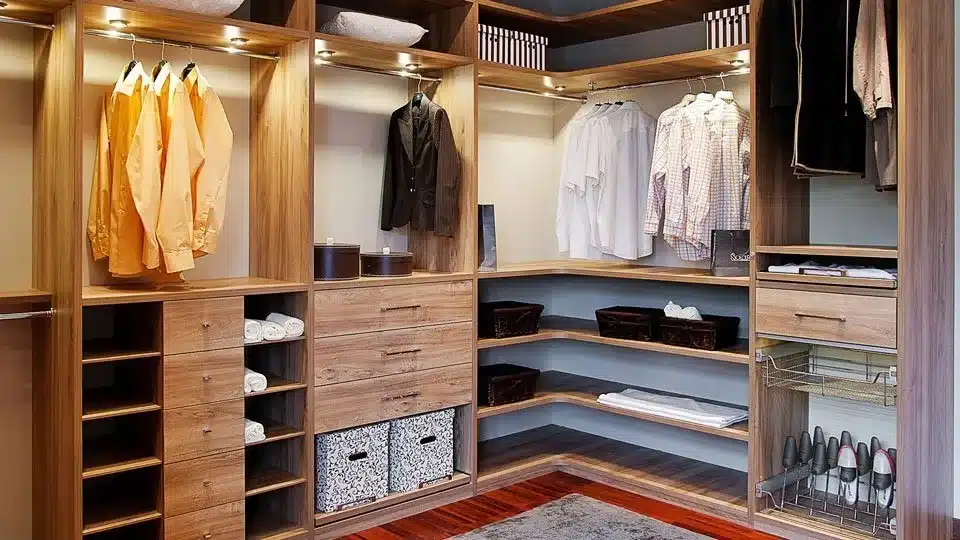
Conclusion
Your wardrobe is more than a collection of garments; it’s an extension of your identity, a testament to your growth, and a canvas for your creativity. “How To Redo Wardrobe” is your companion in this transformative journey of self-expression and reinvention. The price of revamping your wardrobe can vary greatly depending on a number of different aspects, such as your location, the degree of the makeover, the quality of the goods you’re looking to add, and whether you’re working with existing pieces or starting from fresh.
As you embrace the process of revamping your wardrobe, remember that every choice you make reflects your evolving sense of self. Just as each garment tells a story, your revamped closet weaves a narrative of your aspirations, values, and individuality. Whether wardrobes should be the same color as walls depends on your personal preferences, design goals, and the overall aesthetic you’re trying to achieve in your space. There’s no hard and fast rule, and both matching and contrasting color schemes can work well.
As you stand before your newly curated collection, filled with pieces that resonate with your essence, take pride in your journey. The journey of wardrobe update is a reminder that growth is beautiful, and your style is an ever-evolving masterpiece. Keep your closet organized so you can easily see and access your updated pieces. So step into the world with renewed flair, inspired by the freedom to express yourself through your revamped wardrobe. Whether wardrobes should be the same color as walls depends on your personal preferences, design goals, and the overall aesthetic you’re trying to achieve in your space. There’s no hard and fast rule, and both matching and contrasting color schemes can work well.



